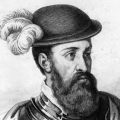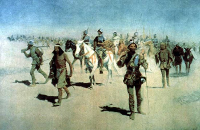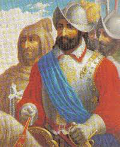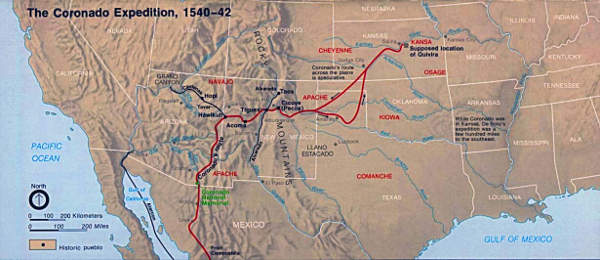Conquistador Francisco Vásquez de Coronado
Francisco Vásquez de Coronado was a 16th-Century Spanish conquistador known for his determined yet ultimately fruitless pursuit of the fabled Seven Cities of Gold. In the process, he and his men were the first Europeans to see both the Colorado River and the Grand Canyon. 
Coronado was born in Salamanca, Spain, in 1510. He was 25 when he sailed to the New World, in the wake of Spain's occupation of large swathes of North America after the arrival of Christopher Columbus 28 years earlier and the subsequent Treaty of Tordesillas, which assigned to Spain the right to colonize that part of the New World. The Spanish viceroy, Antonio de Mendoza, was also on this voyage; the two men became friends. He settled in Mexico City, in New Spain, and married Beatriz de Estrada, the daughter of the colonial treasurer; they eventually had eight children. He was then appointed governor of the Nueva Galicia province, which included what is now the states of Jalisco, Nayarit, and Sinaloa. Coronado was one of many people enchanted by the legends of the Seven Cities of Gold. He was one of several who did something about it. He needed a lot of money to finance his expedition; he convinced his friend Antonio de Mendoza to pay some of the costs, and he also pawned his wife's enormous estate. 
Captivated by stories brought back by an earlier Spanish expedition, that of Álvar Núñez Cabeza de Vaca, Coronado and his force of 400 European soldiers and more than 1,300 Native Americans set out from Compostela on Feb. 23, 1540 and went through what is now Arizona, Arkansas, Colorado, Kansas, Missouri, New Mexico, Oklahoma, and Texas. One contingent, led by Hernando de Alarcón, went via the Guadalupe River; Coronado led the other force, which traveled on land. They all found rumors but nothing more. Most of his force returned to Mexico in 1541; Coronado and a much smaller forced carried on, eventually returning empty-handed in 1542. He was wounded in a battle with Zuni, who refused to allow Coronado and his men entry into their village. This was a recurring pattern. While Coronado was convalescing, he sent out a few groups of men:
Coronado recovered enough to set up winter quarters in a village called Tiguex. The Spanish and local Native Americans clashed, resulting in hundreds of Tiguex deaths. 
Coronado was off again, following a local guide known as "the Turk" who claimed to have knowledge of the golden cities that the Spanish so desperately wanted to find. The capital of riches was said to be called Quivira; they found that settlement in what is now Kansas but found none of the riches that were said to be there. The one primary benefit of Coronado's expeditions was the journal that he kept as he went. One thing he saw a lot of was bison, which he called cows. His descriptions of the land that he and his men traveled through informed subsequent expeditions. Coronado never found what he was seeking. A fall from his horse left him injured again, and he decided to return home. He was governor again and was then forced out in 1544 because of bankruptcy. Contributing to this was Spanish officials' denunciation of his expeditions as a failure; among those criticizing him was his old friend Mendoza. Spanish officials launched two investigations into his conduct but found no reason to punish him in the end. His last public assignment was as a member of the Mexico City council. He died on Sept, 22, 1554. A chronicle of his journeys was published many years later. |
|
Social Studies for Kids
copyright 2002–2025
David White






